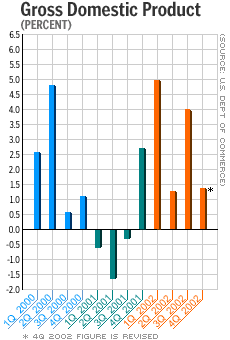NEW YORK (CNN/Money) -
The U.S. economy was a bit stronger in the fourth quarter of 2002 than initially estimated, but still grew at a relatively weak pace, the government said Friday.
Gross domestic product (GDP), the broadest measure of the world's largest economy, grew at a 1.4 percent rate in the quarter after growing at a 4 percent rate in the third quarter, the Commerce Department reported.
The reading on GDP, the broadest measure of economic growth, was revised up from an initial reading of 0.7 percent. Economists, on average, expected a revision to 1.0 percent growth, according to Briefing.com.

"This report does not change the big picture, but it lifts the starting point for growth in both the first quarter and 2003 as a whole; good news," said Ian Shepherdson, chief U.S. economist at High Frequency Economics Ltd.
The report had little impact on U.S. stock market futures, which traded higher, pointing to a positive opening on Wall Street. Treasury bond prices fell.
After suffering from a recession that began in March 2001 and likely ended late that year or early in 2002, the U.S. economy has had an up-and-down recovery period.
GDP growth has bounced as high as 5 percent in the first quarter of 2002 and 4 percent in the third quarter and as low as 1.3 percent in the second quarter and 1.4 percent in the fourth.
Economic activity has been hurt by corporate accounting scandals, a lingering bear market in stocks and the slow build-up to a U.S.-led war in Iraq.
Though businesses have been spending money, mainly to rebuild inventories, replace old equipment and increase productivity to keep up with competitors, they haven't embarked on the kind of major investment plans necessary to keep the economy going strong.
What's more, businesses have managed to squeeze more work out of fewer workers, meaning the labor market has never really recovered from massive layoffs in 2001.
| Related stories
|

|
|
|
|
Non-farm payrolls are 1.6 million jobs trimmer than they were in March 2001, and the unemployment rate has hovered between 5.7 percent and 6.0 percent since December 2001.
Meanwhile, skyrocketing oil prices, along with higher prices for other commodities, have pinched corporate profits in recent months, meaning companies are still in no hurry to add costs by hiring new workers.
And higher oil, natural gas and gasoline prices are also pinching consumers' wallets, curbing discretionary spending and generally weighing on confidence.
Many economists think every $10 gain in the price of a barrel of crude oil shaves 0.5 percentage points from GDP growth, and oil has jumped from about $25 a barrel in November 2002 to nearly $40 a barrel on Thursday.
Though most economists still think the economy will grow in the first quarter, the jump in oil prices could seriously undermine that growth, and war -- if it comes early in March, as some analysts expect -- could slow growth even more.
In the fourth quarter, consumer spending, which makes up more than two-thirds of the total economy, grew at a 1.5 percent rate in the quarter, the slowest pace since a matching 1.5 percent rate in the third quarter of 2001, which included the Sept. 11 terror attacks.
But a dramatic plunge in the pace of automobile sales accounted for a great deal of the slowdown. Sales of autos and auto parts fell 6.16 percent in the quarter, contributing to an 8.5 percent slowdown in sales of consumer durable goods, items meant to last three years or more.
On the brighter side, business spending rose at a 2.5 percent pace, better than the 1.5 percent rate initially reported, and the best growth since the third quarter of 2000. Spending on equipment and software rose for the third straight quarter.
Businesses also added to their inventories at a $24.7 billion rate, the fastest pace since the fourth quarter of 2000 and much stronger than the $3.3 billion first estimated. Inventory spending added 0.24 percentage points to total GDP growth.
The GDP price deflator, a key measure of inflation, rose to a 1.6 percent rate in the quarter, the highest since the third quarter of 2001.

|

